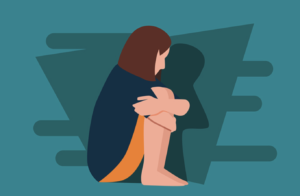Living With PTSD
Living with post-traumatic stress disorder, or PTSD, is like being followed by an invisible shadow. Situations are overwhelming to cope with. Waves of panic engulf your being. This overpowering feeling can present itself at any moment.
It’s tough to find safe spaces, both mentally and physically, when you have PTSD as you’re in a heightened state of alarm. For some, this is exacerbated by restless nights and bouts of insomnia. While you try to live as normally as you can, many days present a challenge.
You can experience few or no symptoms for months or years but still feel that shadow stalking you. If another traumatizing event re-triggers PTSD, symptoms and feelings that you assumed were shelved away can show themselves again.
With PTSD, you feel caught in this overwhelming spiral.
What Is Trauma Associated With PTSD?
- Whatever interferes with your ability to process information, live life and feel good is classified as trauma. Most adults have been through some form of trauma, with 70% of adults in the U.S. reporting having experienced trauma at one point in their lives.
- Trauma won’t impact two people in the same way because our experiences are very much individual. One person might find an event too overwhelming to cope with while someone else barely notices it at all. The severity of symptoms that show up after a traumatic event also varies from person to person. Of those who reported experiencing trauma, 20% go on to develop PTSD.
Understanding Post-Traumatic Stress Disorder
PTSD is a set of symptoms that develop after a traumatizing event that leaves you overwhelmed and unable to cope. Not all traumatic events that lead to PTSD are “large-T” traumas — overt events like abuse or combat, for instance. An accumulation of “small-t” traumas, less pronounced yet distressing events, can also develop into PTSD. Examples include divorce, financial stress and family conflict, to name a few.
The thought of revisiting past trauma is intimidating. I focus on ensuring you feel like you’re in a safe space throughout treatment. Once you’re in a fully relaxed state, you’re better prepared to work on yourself.
Who Is at Risk of Forming PTSD Related to Extreme Trauma?
There’s a common notion that PTSD arises primarily from combat-related trauma. But in truth, anyone who’s experienced trauma can develop PTSD. Post-traumatic stress disorder can stem from childhood trauma, emotional abuse or a traumatic event in your adult years.
Certain situations put individuals at a higher risk of developing post-traumatic stress disorder, such ase:
- Ongoing stress
- A history of trauma or abuse
- A family history of mental health issues or addiction
- Lack of support network
Know that PTSD is NOT a character flaw. It’s your body’s way of protecting you from deep wounds. PTSD occurs when you are too overwhelmed to cope with trauma and when symptoms that result from feeling overwhelmed show up for certain amounts of time.
Common Signs Associated With PTSD Caused by Trauma
The symptoms and severity of PTSD look different for each person, but often include:
- Flashbacks
- Recurring memories
- Nightmares
- Social isolation and withdrawal
- Lack of emotion or numbness
- Feeling of hopelessness
- Memory loss
- •Concentration loss
- Irritability
- Insomnia
- Heightened alert
- Hyper-vigilance
- Muscle tension
- Overwhelming guilt or shame
You’re considered to have post-traumatic stress disorder if one or more of these symptoms last over a month following a traumatic event. In long-term PTSD, these symptoms will show up regularly for over a month or become more severe.
Another form of post-traumatic stress disorder is called complex PTSD. This related condition shares many of PTSD’s traits along with some additional symptoms, including:
- Depression
- Difficulty controlling intense emotions
- Anger or distrust toward the world
- Feeling permanently damaged or worthless
- Seeing yourself as different than others
- The belief that nobody can grasp what’s happened to you
- Severe physical symptoms, i.e, headaches, chest pain, stomach issues
- Suicidal feelings
How to Treat PTSD
Standard PTSD treatments focus on symptom management or learning skills that can help you cope with the impact trauma has had on your life. Modern clinicians provide numerous treatment options for helping clients address post-traumatic stress disorder. A few interventions that have helped many people find relief from their PTSD symptom follow:
- Cognitive-behavioral therapy (CBT): This therapeutic modality focuses on the relationship between thoughts and feelings and subsequent behaviors. It targets current symptoms and problems and seeks to help clients change negative patterns that make it difficult to function.
- •Prolonged exposure: This type of CBT helps clients gradually approach the memories and feelings surrounding past trauma and face what’s been avoided. The goal is to help individuals learn that trauma-related memories and cues are not dangerous.
- EMDR for PTSD: Eye movement desensitization and reprocessing therapy encourages clients to briefly focus on past trauma while also engaging in bilateral stimulation, such as using their eyes to track the clinician’s hand. This technique can potentially reduce the vividness and emotion associated with traumatic memories.
- •Medications: Antidepressant medications are often prescribed to those with PTSD.
- Ketamine for PTSD: Growing evidence suggests that ketamine may be more effective than standard medications at easing PTSD symptoms. It can have a positive impact on trauma-related memories and physical symptoms. Ketamine can also be used with talk therapy to help clients speak about trauma or release blocked emotions.
- Most people receive PTSD treatment in an outpatient setting; i.e., from a licensed therapist. In a residential PTSD rehab, clients can heal from past trauma in an environment of care and safety. A holistic approach to PTSD treatment blends the best of modern, science-based techniques with alternative treatment modalities.
Other Treatment Options: Holistic Alternative Non-12 Step Treatment for Trauma and PTSD
There is a different way to address the emotional, spiritual and physical pain associated with post-traumatic stress disorder. An integrative approach sees you as a whole person in body, mind, soul and spirit. While some science-based treatment options are used, a non-12 Step treatment program for PTSD is more holistic.
- The complete picture of your health and well-being is addressed: Trauma affects more than the mind; other parts of yourself also feel its impact. Equal importance’s placed on the clinical, scientific, physical, energetic and nutritional aspects of trauma recovery, leaving no part ignored.
- In an integrative program, each component comes together to create an organized and powerful experience that guides you through all stages of healing.
- The team has intimate knowledge of holistic perspectives: Clinicians can integrate these perspectives into your treatment program. This ensures your experience is highly coordinated, with all parts of your recovery journey incorporated.
A holistic, non-12 Step approach to PTSD treatment. Trauma tends to bury itself deep. While trauma does impact our mind, it also goes beyond that. It can be remembered in both conscious and subconscious ways.
- Body: Your body remembers trauma — past traumatic events leave physical imprints on our cells.
- Mind: Your thoughts surrounding a traumatic experience are often disempowering. We hold on to these false beliefs, and they continue to build over time.
- Soul: When you experience trauma, you disconnect from the parts of Self that used to feel joy, love and belonging. You experience a soul-loss.
- Spirit: Our spirit, or electromagnetic energy field, affects our nervous system. When trauma disrupts our electromagnetic energy field, it ultimately puts us in a state of hypervigilance.
Our holistic treatment for PTSD addresses all parts of your being impacted by trauma with therapeutic modalities that are both conventional and alternative. This complete picture approach allows you to heal from the inside out and create a powerful life change.
How to Move Forward With Alternative Holistic Treatment for PTSD
Conventional PTSD treatment places emphasis on symptom management. Rather than mitigating behaviors that keep you feeling stuck, a good therapists gets underneath it all. The root of trauma lives in this deeper place. When you confront our trauma in that space, you can release it from our being and create a life truly free from it.
What the healing process looks like:
The programs starts by calming down your nervous system via serene landscapes, comfortable living spaces, talk therapies, daily mindfulness practice, organic food program and promoting the calming process. Once you’re brought out of a heightened state and are fully relaxed, we can start to get to work.
The program has four distinct, powerful stages of healing:
- Identify disempowering beliefs and trauma that you’re holding onto, plus the coping strategies you’ve used to feel better.
- Shed light on parts of yourself that have been hidden from your view.
- Recover positive parts of yourself that you’ve lost along the way, and empower yourself to envision a new future.
- Implement what you’ve learned to create powerful changes and live out your life’s purpose.
- You move from one stage of the healing journey to the next at a pace you’re comfortable with. The therapist want to ensure that you are able to absorb key information without feeling overwhelmed.
Why Choose Non-12 Step Holistic Treatment for Trauma-Related PTSD
Good therapists see your inner strength and help you see it, too, which makes them fundamentally different from conventional trauma-related PTSD treatment programs, based more on symptom management. A good therapist believes in your ability to fully heal from PTSD. When you shed limiting beliefs, the room for new possibilities is endless.
Within the comfort and safety of treatment, you are empowered to embark on your healing journey. A fundamental, positive shift in clients’ recovery is seen as they take back their power. When you believe you can, the rest tends to follow.
Your ability to fully heal is backed by the science of neurogenesis and neuroplasticity. These point to your brain’s capacity to create new neural pathways throughout your lifetime. Post-traumatic stress disorder initially alters your hormone levels and neural pathways. But you can change how your brain functions and correct previous disruptions to your neural system.
Many people struggling with PTSD use substances to numb the painful symptoms and quiet traumatic memories. If you’ve fallen prey to drug or alcohol misuse, we offer PTSD treatment and addiction help, treating each of these co-occurring conditions as their own diagnosis during your time with us.
Take Action and Get Treatment Today
Post-traumatic stress disorder can stalk people for a long time. But you no longer need to live in its shadows. It is possible to get to the core of your trauma and finally release it from your being.
You can heal from post-traumatic stress disorder. Our holistic program helps guide you towards a powerful new life free from the grips of trauma.

